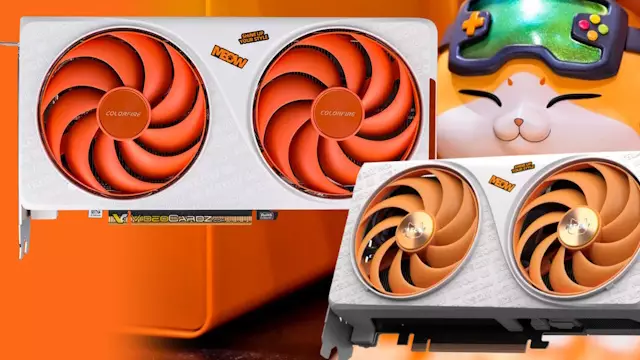In the crowded world of GPU manufacturing, standing out often means walking a fine line between innovation and impracticality. Chinese manufacturer Colorful, known for its distinctive and sometimes eccentric designs, has unveiled the Colorfire Meow series featuring Nvidia’s freshly announced RTX 5050 graphics cards. These GPUs are immediately eye-catching with their vivid orange fans and playful cat-themed chassis—a stark departure from the usual sleek, utilitarian graphics card aesthetic. However, while these cards certainly bring a splash of artistry to hardware, their practical appeal raises some genuine head-scratching questions.
Colorful’s attempt to create a visually unique product is commendable. The Meow series, with its embossed “Meow” text and adorable cat face motifs coupled with bold orange cooling fans, provides a fresh breath of personality within a sea of generic black and silver GPUs. The design clearly defines the brand’s effort to segment this lineup from its traditional iGame Ultra series, which itself recently added an RTX 5050 in a graffiti-styled white and pink variant. This deliberate visual separation signals that Colorful is experimenting, perhaps even taking risks, with its market positioning.
Yet, appealing design alone doesn’t guarantee success. At the end of the day, most gamers and creators prioritize performance and value first, making the unconventional aesthetics a secondary consideration. The question is whether Colorful’s style innovation compensates for the RTX 5050’s underwhelming promise on the technical front.
The 5050’s Performance Puzzle: A Step Behind or Ahead?
Nvidia’s RTX 50 series shook up expectations by launching earlier than many anticipated, but the mid-range RTX 5050 specifically has spawned mixed reactions due to its somewhat confounding specifications. The card sits awkwardly in the market—its performance reportedly edging slightly below the prior-generation RTX 4060, yet it boasts support for DLSS 4, Nvidia’s latest AI-driven upscaling technology.
DLSS 4 is arguably the most compelling feature here and could offer significant improvements in frame generation and overall efficiency, potentially bridging the gap between hardware power and user experience. However, without hands-on benchmarks or reviews yet, the enthusiasm remains speculative. For gamers strictly chasing raw throughput or value per dollar, a card with specs inferior to an older model and a fresh price tag can be a tough sell.
This is especially true in an environment where consumers expect iterative hardware upgrades to deliver clear and measurable improvements. The 5050’s positioning challenges this notion, potentially forcing buyers to rely on upcoming software innovations rather than straightforward hardware muscle to justify their investment.
Brand Strategy and Market Signaling
Colorful’s decision to place the RTX 5050 in both its experimental Meow series and the more conventional iGame Ultra lineup illustrates an intriguing brand strategy. The Meow series feels like an R&D playground—where the company tests unconventional designs and possibly gauges consumer reaction to novel form factors and aesthetics. The bright orange fans and cat motifs lend it an identity that could resonate with niche audiences, such as PC builders favoring thematic or eccentric rigs.
Conversely, adding the same GPU to the iGame Ultra lineup, which traditionally appeals to enthusiasts looking for high performance and refined style, muddies the waters. It’s unusual to see a GPU with specs that seem to undercut an already established card integrated into a premium series. This might dilute the premium brand value or confuse buyers about the target customer for the 5050.
The dual approach could be a reflection of uncertainty—or a hedge—by Colorful amid Nvidia’s somewhat muddled 50-series introduction. If the RTX 5050 is a low-cost entry point to experience DLSS 4’s benefits, then diversification across product lines and designs can maximize exposure and appeal.
Pragmatism Versus Playfulness in GPU Buying Choices
While the industry often pitches shiny and powerful graphics cards to gamers, there is an undeniable charm in hardware that dares to be different. Colorful’s Meow card, small with dual fans and a quirky yet neat design, could spark interest among budget-conscious builders prioritizing aesthetics as much as function. The company claims the Meow lineup is particularly optimized for synergistic cooling, which, if true, would add practical merit to the visual novelty.
However, the skepticism is justified. Without established benchmarks, and considering the card’s spec positioning, the 5050 feels more like a curiosity than a necessity. It might appeal to early adopters intrigued by DLSS 4 or those building an unconventional rig, but for mainstream users, the card’s practical value proposition remains unclear—as does Colorful’s rationale for placing it so prominently across contrasting product lines.
With these cards hitting the market unexpectedly early, we’re left to watch closely whether this bold, orange cat-themed gamble translates into a compelling performance-to-price ratio—or merely a memorable aesthetic oddity in an otherwise competitive GPU landscape.

